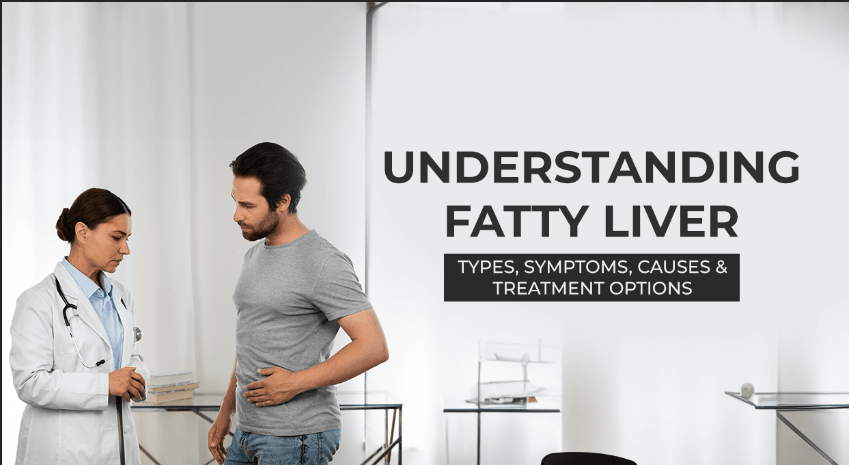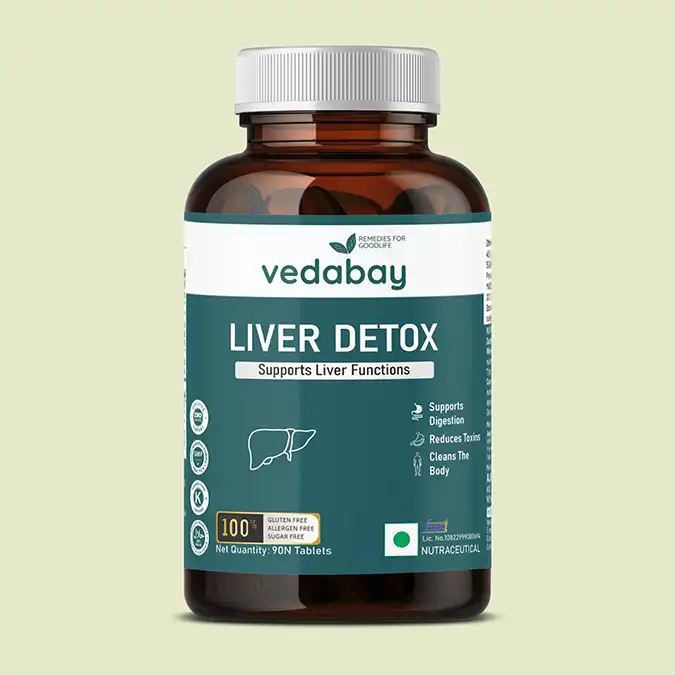Fatty liver disease is a condition that is characterized by toxic fat accumulation in liver cells. It affects more males than females and can be non-fatty or alcoholic. It leads to metabolic disorders like insulin resistance and overweight issues.

What is a Fatty Liver?
The liver is the most important and largest organ. It helps improve digestion of food, maintaining energy and eliminating toxic elements from the body. Toxic fats accumulate in the liver and that leads to two categories due to the consumption of alcohol or heavy toxic food items :
1. Alcoholic Fatty Liver Disease
Drinking alcohol worsens liver conditions and damages liver cells with toxic fats. As a result of excessive drinking, one might suffer severely from liver cirrhosis, alcoholic hepatitis and cirrhosis.

2. Non-Alcoholic Fatty Liver Disease
In such conditions, liver cells get damaged and undergo the problem of non-alcoholic fatty liver disease. There has not been an exact reason found connecting with non-alcoholic fatty liver disease. Excess fats and diabetic conditions are underlying conditions to cause such diseases. Two types of non-fatty liver diseases are there:
- Simply Fatty
You may simply have fatty liver conditions with inflammatory conditions. It may or may not affect the liver conditions. But it may not appear to be as harmful as expected.
- Non-Alcoholic Steatohepatitis
It is another form of non-alcoholic fatty liver disease wherein the liver cells get damaged by the accumulation of unhealthy fats. Some people may have signs of jaundice with eyes and skin being highly affected. Some may not. It might into cirrhosis of the liver if the treatment is not given on time. However, some might not be affected by worse conditions of the liver. This liver condition identifies with someone who is not abusing alcohol.
| Image | Product Name | Product Review | Price |
|---|---|---|---|
-w.webp) |
Liver Care | Ayurvedic Medicine for Fatty Liver |  |
Check Price |
 |
Liver Detox Tablets | Liver Care | Ayurvedic Medicine for Fatty Liver |  |
Check Price |
Verifying the grades of fatty liver conditions requires deeper analysis followed by the necessary treatments.
Verifying the Severity of the Disease
Grading of the disease will determine the severity of the worst liver conditions and inflammatory conditions. Non-alcoholic fatty liver disease can be found due to increasing fibrosis conditions from mild to severe.
Determining the Risk Stratification
With the advancement in fibrosis, one will be affected with various complications which may be like cirrhosis, liver failure and hepatocellular carcinoma. There is a need to closely monitor the progression of the disease and take appropriate treatment procedures.
Appropriate Diagnosis
It becomes necessary to find accurate reasons for someone being affected with fatty liver of alcoholic or non-alcoholic type. It will help the doctor to analyze and take steps for appropriate treatment procedures.
Planning Treatment
There may be a requirement for suitable treatment procedures according to varying grades of liver disorders. The doctors would help identify lifestyle changes like dietary transformations, weight loss and improvement in physical activities. Extensive studies on fatty liver conditions help in taking appropriate treatment procedures.
Guiding and Creating Awareness of Fatty Liver Conditions
It becomes necessary to create awareness regarding fatty liver conditions among patients. It will help the patient to understand their health better and the reasons that cause disorders in the liver. The patient might move forward with specific treatments as to find the progress of the disease and also he or she will be able to analyze how well responding to the treatment.
It is required to find out the exact causes of failure in liver conditions. There is a need to throw light on the symptoms, causes and treatment options.
- Raise awareness
- Facilitating appropriate knowledge on various types of liver diseases.
- Verifying the symptoms and risk conditions
- Highlighting the importance of care in a personal way
- Suggesting appropriate steps for controlling the health conditions.
Nonalcoholic fatty liver disease and alcoholic fatty liver disease have two distinct conditions damaging the liver with different factors.:
Reasons
1. Non-Alcoholic Fatty Liver Disease
Non-alcoholic fatty liver disease-affected people are found with high levels of glucose tolerance, insulin resistance, type 2 diabetic conditions and bad cholesterol. This form of fatty liver disease applies to people who depend on high-saturated and unsaturated fatty foods and processed items regularly. They get affected by the accumulation of fats in the liver and suffer damage to liver cells even without drinking alcohol.
2. Alcoholic Fatty Liver Disease
It can affect anyone who is depending on alcohol regularly or consuming alcohol excessively. However, not every person might suffer from such a deadly disease. It is because every person has a unique form of metabolism, genetic reasons and health grounds.
Alcohol Drinking

1. Non-Alcoholic Fatty Liver Disease
Even though a person might be relying on alcohol drinking moderately, but then one might not experience being affected by fatty liver disease under the influence of alcohol. There may be other underlying factors which may be selecting an unhealthy diet and lifestyle disorders.
2. Alcoholic Fatty Liver Disease
In this form of fatty liver disease, alcohol drinking is found to be the primary cause. Excess alcohol consumption might seem to do worse to many by affecting the liver cells the most and so does weakening the heart conditions.
Impacts of Alcohol Drinking on the Global Population
1. Non Fatty Liver Disease
Obesity is a global problem and thus leads to the problem of fatty liver. The majority of the population all across the globe is suffering from non-alcoholic fatty liver disease.
2. Alcoholic Fatty Liver Disease
his condition is not that common. Still, it is a matter of worry because the rate of the alcoholic population is increasing day by day.
Influence of The Disease
1. Non-Alcoholic Fatty Disease
The resultant factor of this form of disease will be deadly. One might get affected by a simple fatty liver and later it might turn out to be non-alcoholic steatohepatitis. It would inflame the liver further and destroy the cells of the liver.
2. Alcoholic Fatty Liver Disease
Alcoholism can be matter of root cause of several types of life-threatening diseases and it can turn out to be difficult for many to survive with such diseases. It may begin with alcoholic fatty liver conditions and make your liver conditions worse by causing cirrhosis, fibrosis and further advanced form of liver disorders.
Medication and Type of Treatment
1. Non Fatty Liver Disease
Lifestyle alterations what expected to make the patient better in terms of health conditions. It might cause significant weight loss. Wholegrains, lean meat, fruits and veggies are the food items that can make the liver work in a better way.
2. Alcoholic Fatty Liver Disease
Avoiding alcohol drinking must be the preliminary step for reversing the disease of alcoholic fatty liver. Appropriate care and nutritional support with herbs like Amla, Vidarikand, lemon, tulsi, punarnava and giloy might show steady recovery from alcohol drinking and cause no side effects.
Overview of the Grading System for Fatty Liver (Grade 1, Grade 2, Grade 3)

Growth of fatty liver is seen in three different stages:
Stage-1: It happens when the percentage of fats exists from 5% to 33% in the liver.
Stage-2: It happens when 34% to 66% percent of the fats settle in the liver.
Stage-3: It is when nearly 66% of the fats get into the liver.
Types of Fatty Liver
A. Grade-1 Fatty Liver
It is the preliminary stage of liver disorder and it occurs as a result of excess fat accumulation in the liver cells.
1. Description and Characteristics
In this preliminary stage of grade 1 fatty liver, one might not get the hint of the fats accumulating in the liver. There may less chances of damage to liver cells under the influence of the accumulation of fats. It does require attention with lifestyle modifications and later it can turn out life-threatening with the increase in the destruction of liver cells.
2. Diagnosis and Imaging Findings
It requires a deeper analysis of the fatty liver conditions and that is with the support of an MRI scan, ultrasound and CT scan. Imaging technology will throw light on to what extent the fats have accumulated in the liver. Abnormalities in the liver can be traced through liver function tests and doctors might attend with specific medication and treatment. The liver might show mild to severe complications due to the elevation of ALT and AST enzymes. Such enzymes may incur injury or damage to liver cells.
3. Prognosis and Potential Complications
- The prognosis of fatty liver disease awaits proper analysis of the progress of the disease with different forms of medical testing and scanning. It involves the findings and deeper analysis through histological methods. It is necessary to check the liver damage with the help of the liver tissue. A liver biopsy will help check how far the liver cells have been damaged due to inflammation and with the advancement of time.
- It involves lifestyle alterations that may bring improvement in liver function. Physical exercise and consumption of plant-based food items, herbs and limiting the consumption of caffeine beverages and avoiding alcohol are such recommendations for such patients.
- The prognosis further highlights how far the patient is responding to hepatotoxic medication and gaining improvement in liver metabolism.
- Complications associated with fatty liver disease often risk the life of a person which may be the occurrence of scariness or fibrosis in the liver, or cancer. Fattiness of the liver burdens the heart with high cholesterol, irregular heartbeat, and then heart attack and stroke.
B. Grade-2 Fatty Liver
1. Explanation of Moderate Fatty Liver
When the fats and carbohydrates accumulate in the fatty liver moderately, it may appear to be less severe than the next advanced stage of liver fibrosis but of course quite advanced from the grade 1 level.
The person who is detected with Grade 2 fatty liver would suffer from inflammatory conditions but comparatively less considering the advanced stage.
2. Symptoms and Progression
Compared to milder or stage 1 fatty liver, moderate accumulation of fats and carbohydrates in the liver seems to bother the patient with the given symptoms:
- Pain in the abdomen
- Vomiting and loss of appetite.
- Skin appearing yellowish like jaundice patients.
- White area of the eyes appears to be yellow
- Swollen legs and abdomen
3. Treatment Options and Lifestyle Recommendations
With the accumulation of 10 % to 20% of fats in the liver area, the liver becomes enlarged. The intensity of symptoms of fatty liver disease in any person may vary from one person to another. Symptoms of bloating of stomach, sleep disturbances and thirst become prominent in many persons undergoing stage 2.
There is no exact cure for the stage 2 fatty liver disease,
- Medication
There is no appropriate medication for anyone who is diagnosed with the symptoms of stage 2 fatty liver. Attempts are being made through medical research to find suitable medication to execute the treatment process.
- Weight Management

Practicing regular exercise, going for a morning walk and a night walk after dinner will reduce the excess fats in the liver, weight management and make you active.
- Dietary Changes

It is always better to eat anything less oily and fatty. Avoiding the consumption of clarified butter, normal butter and refined grains, and caffeine beverages is advisable.
Quit alcohol is another way to reduce the intensity of inflammation and drinking a lot of water.
C. Grade-3 Fatty Liver (Severe Steatosis)
It occurs when the accumulation of toxic fats in the liver goes beyond 66% and makes the person severely from pain and inflammation in the upper abdomen area. Chances of recovery in this stage are minimal and worsen with revealing signs of scary liver or cirrhosis.
1. Understanding Severe Fatty Liver and Its Implications
This is the last stage of fatty liver disease wherein the patient’s liver cells are almost damaged and chances of complications rise in the form of jaundice, cirrhosis of the liver and liver cancer. There are fewer chances of recovery in this advanced stage. Blood vessels which are arteries, capillaries and veins start malfunctioning and thus fail to transport the nutrients and blood to various parts of the body.
Skin and eyes may turn pale yellow due to lack of blood and make the person extremely weak.
The patient might reach the stage of coma due to a lack of blood in the body and may require hemodialysis to eliminate wasteful substances and fluid from the blood.
2. Symptoms and Risk Factors
Symptoms of fatty liver in stage 3 are far more revealing and severe than in stage 1 and stage 2 deterring chances of recovery.:
- Weight reduction.
- Weakness due to edema, a fluid accumulation that results in leg swelling.
- Vomiting
- Appetite decline.
- Jaundice, or skin and eye yellowing
- Bewilderment in the mind.
- Burning
3. Management Strategies and Medical Interventions
Usually, in this stage of fatty liver disease, hemodialysis is done to cleanse the blood and ease its transportation throughout the day. Liver enzyme and hepatobiliary function are further analyzed by the doctors. Most importantly, hemoglobin analysis and imaging of the hepatobiliary system are done to understand the liver dysfunction in stage 3.
Symptoms of Fatty Liver
A. Common Symptoms Associated with Fatty Liver Disease
- Skin and eyes turning yellow
- Higher form of inflammation in the upper abdomen
- Urine turning dark
- Oral discharge of blood
- Swelling of stomach
- Black stools
Selecting heavy oily and fatty products and refined rice and flour are considered to be unsuitable for liver health.
One should avoid eating such food items which may increase toxic fats and starch in the liver. These food items lack fiber and would not be of any help for liver metabolism. Regular consumption of such food items will heighten the imbalance in metabolism.
Abnormal metabolic conditions often risk the development of fatty liver disease. It may be diabetes type 2, high cholesterol levels, insulin intolerance and sudden weight loss.
B. Contribution of Genetics, Medications, and Other Underlying Conditions
Condition of fatty liver might exist within the family genes wherein the person might be responding to insulin intolerance, inflammation and type 2 diabetes and jaundice. Certain medications also cause enlargement of the liver and thus contribute to damaging the liver cells.
In certain cases of fatty liver, PCOS in women, inflammatory bowel disease and insomnia and hypertension are found to be the underlying conditions.
1. Ayurvedic herbs like turmeric, Guduchi, Kutki, Amla, Bhumyamalaki, and Milk Thistle are traditionally used to support liver health and treat liver disorders, including fatty liver disease.
2. Chinese herbal medicine uses Bupleurum, Milk Thistle, Schisandra, Gynostemma, and Dandelion to regulate liver function, reduce inflammation, and improve detoxification.

Conclusion
Fatty liver disease, categorized into three stages, poses significant health risks. Non-alcoholic fatty liver disease is more common than alcoholic fatty liver disease. Alcohol consumption is crucial. Stage 1 fatty liver is less severe. Recovery methods include lifestyle management and physical exercise. Reversing stage 3 may be challenging due to fat accumulation. The efficacy of natural medicines still awaits further clinical approaches in altering fatty liver.

Bachelor of Ayurveda Medicine and Surgery. general physician, nadi parikshan, online consultation. Dr Mansi is a renowned general physician who holds an experience of more than 5 years. She specializes in treating issues related to respiratory problems, colds, gastrointestinal issues, diabetes, asthma, and more. She aims to study the problem in-depth and treat it to the root, providing a holistic solution.
